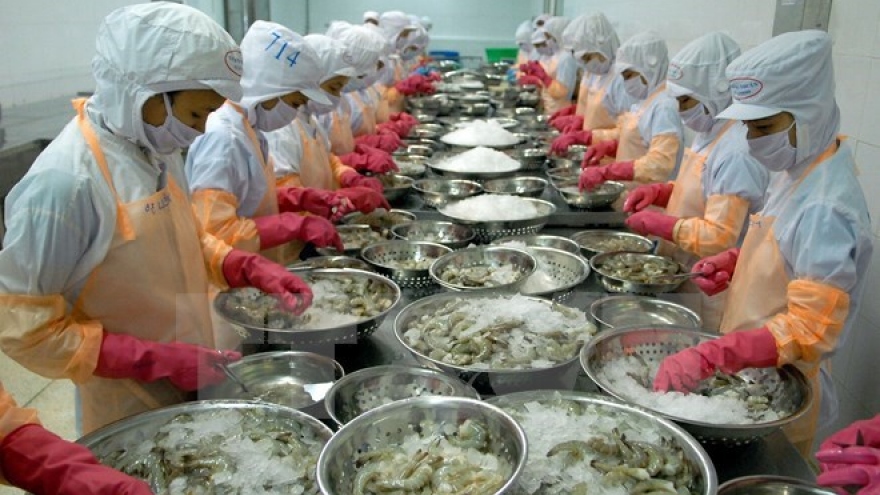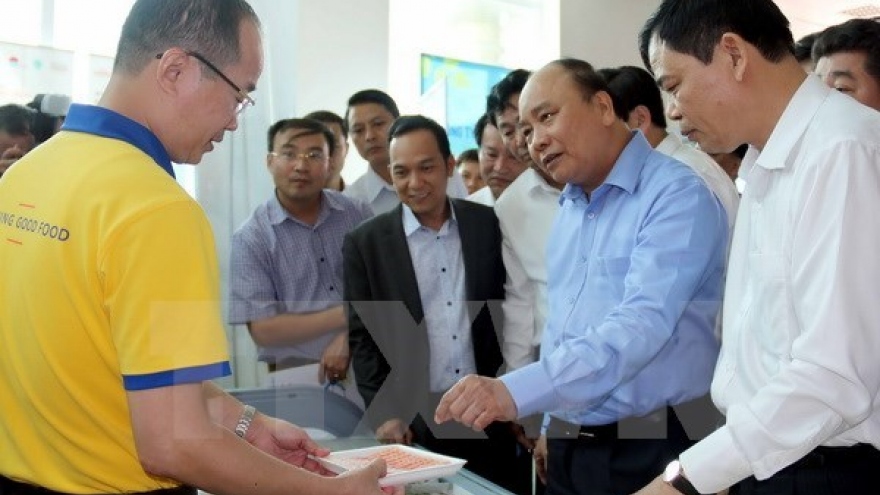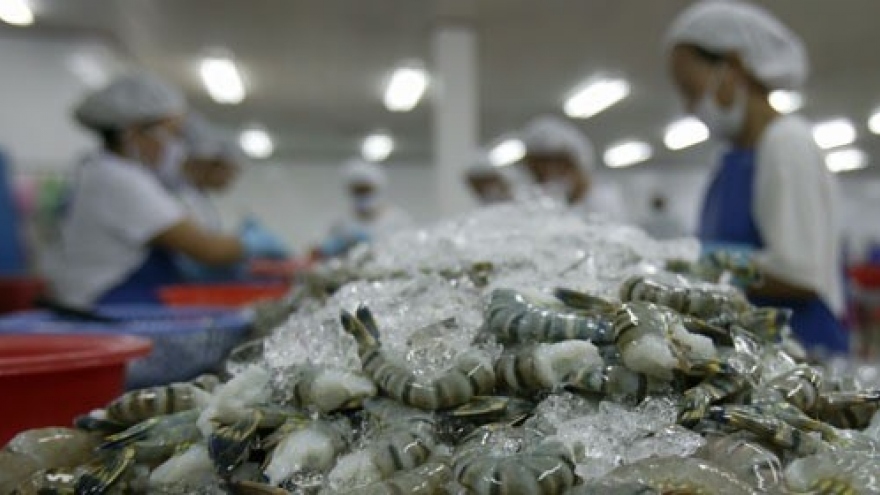PM sets bar high for shrimp exports
The Ministry of Agriculture and Rural Development (MARD) has set a shrimp export target of US$10 billion by 2030.
 |
He went on to say that Vietnam should become the world’s shrimp production base.
But analysts are divided on this.
Some said reaching US$10 billion even in 2025 would be difficult since the agriculture sector faces many challenges like the small, household scale of production, climate change and international integration.
Besides, global seafood exports now are worth around US$130 billion, with shrimp accounting for only around 10 % or $13 billion, they said.
According to the Food Agriculture Organisation of the United Nations, the exports are growing at an average rate of around 15 % a year.
But in reality, it will not be easy to achieve the 15 % growth rate.
Even if it is achieved the global trade in shrimp will only reach $30 billion by 2025.
For Vietnam to achieve the US$10 billion export value by 2025, it would have to both increase shrimp output and value addition of shrimp products.
Experts calculate that if the added value of shrimp is doubled by 2025, the country would earn US$6 billion from exports.
For the US$4 billion remainder, it would have to produce an additional 1 million tonnes of shrimp.
Last year shrimp exports were worth US$3.1 billion. To achieve this, the country had to produce 650,000 tonnes.
Vietnam might be able to produce an additional 1 million tonnes of shrimp, but almost certainly cannot double value addition because its companies already process shrimp using advanced technology.
Le Van Quang, chairman of the Ca Mau-based Minh Phu Seafood JSC, said his company has set a target of exporting US$2 billion worth shrimps by 2021.
It is a feasible plan since the company plans to make major changes to production, marketing and technology application, according to the chairman.
PM Phuc said if Minh Phu alone could export US$2 billion, Ca Mau Province’s total exports could be US$4 billion and the remaining US$6 billion could be managed by other provinces and cities, and the US$10 billion target could be achieved by 2025.
Some analysts concurred with Phuc, saying Vietnam’s shrimp industry has all the conditions necessary to develop and become the world’s shrimp production hub.
But they hastened to point out that the country needs to step up investment in infrastructure for shrimp farming and processing to boost productivity as well as value addition.
Now a full 70 % of costs in shrimp production goes towards feed and medicines, most of which are imported.
Moreover, processors import 17 % of the shrimp they require.
Banks plagued by bad debts, continue to pay low dividends
Tran Thien Nguyen, who owns shares in a joint stock bank based in HCM City, hopes this year it will pay higher dividends than in previous years.
In recent years banks had been paying very low dividends or even nothing, he said.
As a result, dividend payments have always been a hot topic at lenders’annual shareholders meeting in recent years.
Analysts blame the low dividends on banks’ high bad debt levels and their slow recovery.
The chairman of a HCM City-based bank with a chartered capital of VND5 trillion (US$220 million) said last year pre-tax profits were VND484 billion, or 10 % higher than the target.
But it only intends to pay a dividend of around 5 %, the same as the 2015 rate.
He explained that the bank had to set aside a considerable amount of money for risk provisioning since the market was still beset by many difficulties.
The banking sector still has non-performing loans worth about VNĐ200 trillion (US$8.8 billion) bought by the Vietnam Asset Management Company (VAMC) but remaining unresolved.
To settle bad debts, banks are having to use considerable sums of money for their risk provision accounts, which has a big impact on their bottom line.
Eximbank for instance had to set aside VND1.2 trillion last year for provisioning, or 82 % of its net interest income. In the event, its pre-tax profit was only VND300 billion.
Therefore, Eximbank’s after-tax profit was only VND202 billion, 70 % down from 2015.
VIB Bank’s provisioning was VNĐ532 billion, or 56 % of its net interest income.
At the same time banks are also struggling to adopt international bank management standards prescribed under the Basel II accord as required by the central bank.
Basel II requires minimal capital requirements, regulatory supervision and market discipline.
To achieve this goal, banks must increase their capital to meet capital adequacy ratio (CAR) norms. Under Basel II standards, they need to have CAR of around 9 %.
State giant BIDV is one of the lenders that would have to mobilise more capital to meet the 9 % norm.
Opportunities to invest in agriculture
The Việt Nam Rubber Group (VRG) plans to equitise along with 20 of its subsidiaries in the third quarter of this year.
The valuations of the targeted companies have more or less been completed.
VRG is working with auditing firms to check the legal provisions on valuations, and has outlined concrete plans for converting its member companies into shareholding businesses. The company is also looking for strategic investors after equitisation.
The Vietnam Southern Food Corporation (Vinafood 2), whose plan to equitise was approved by the Government, is set to equitise in the fourth quarter.
VRG and Vinafood 2 are among several large companies under the agriculture ministry due to go public this year.
Others include Agriculture Materials Company, Vinafood 1, Việt Nam National Coffee Corporation, and Hạ Long Fisheries Company.
In the first quarter the ministry will disinvest from several companies: Vietnam Fisheries Corporation, Sugar and Sugarcane Company, and Việt Nam Maize Development and Investment Company.
It is planned that around VND2.19 trillion worth of disinvestments will be carried out in the agriculture sector in 2017-20.
Market observers said the fact that several major agricultural companies would be equitised this year and the Government would disinvest from many large companies would provide several opportunities for those who want to invest in the agricultural sector.




